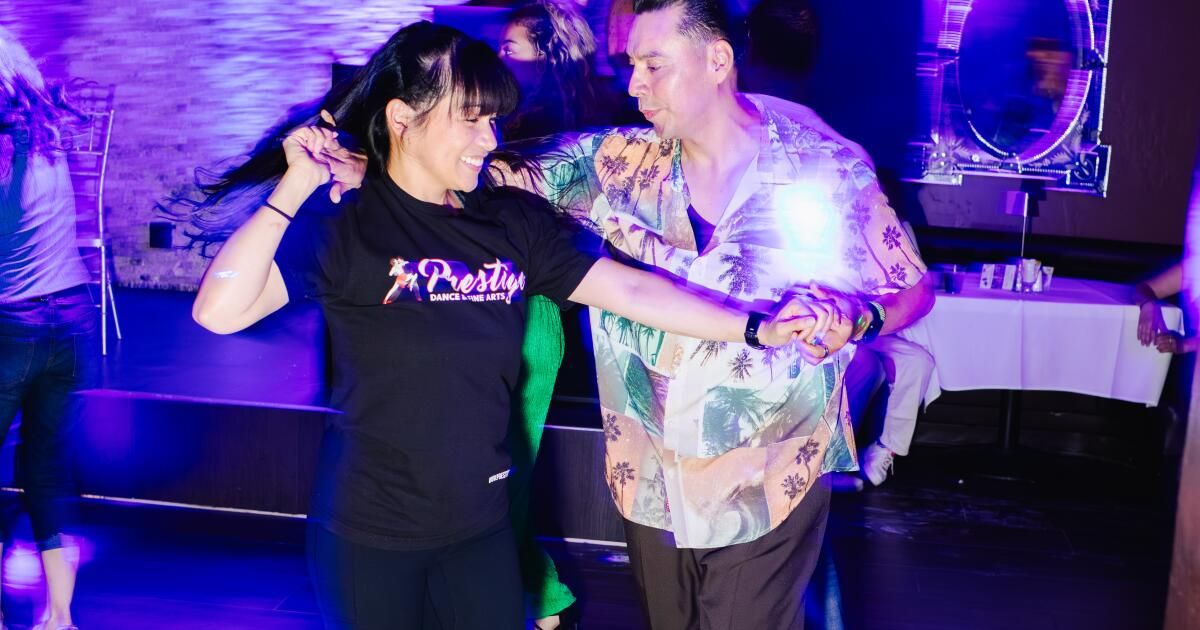In the working-class city of Commerce, where cars zip by on freeways and Citadel Outlets tower over neighborhoods, there's a steakhouse called Stevens. During the day, it's a charming, classic old restaurant where workers come for hearty, leisurely meals.
But every Sunday night the outside world disappears.
As waiters move around in starched shirts, couples lead hands to the dance floor in the restaurant's lounge, where the Stevens tradition of Salsa Sundays has brought the community together for 73 years.
Every Sunday at 7 pm, beginner lessons begin at Stevens Steakhouse.
(Emil Ravelo / For The Times)
An eight-piece band plays brass, electric guitar, bongos and timpani, filling the room with music as dancers spin in dizzying variety. One attendee, Amy Hernandez, 29, greets some familiar faces before entering the dance floor, twirling with confident steps and a wide smile on her face.
Hernández is part of a resurgence that has gotten young people excited about salsa music and flocking to Stevens. He grew up watching his father dance salsa, but began diving back into the genre on his own to find solace during the Los Angeles wildfires earlier this year. She credits Bad Bunny’s “Debí Tirar Más Fotos” for reawakening her interest.
“It was very healing for me,” he says of the album, which combines old-school Puerto Rican samples with Latin dance and reggaeton influences for an emotional imagination of Puerto Rican identity.

For decades, Stevens has brought together friends, couples and families for live music and dancing.
(Emil Ravelo/For The Times)
When college friends recommended Stevens as an affordable place to dance, Hernandez mentioned it in passing to his father. “He laughed and said, 'I remember that place. I danced there too,'” Hernández says.
Increasingly popular artists in the Latin fusion genre of reggaeton are returning to tradition. Along with the music of Bad Bunny, who will headline the upcoming Super Bowl halftime show, you can find references to classic salsa in reggaeton star Rauw Alejandro's latest album, “Cosa Nuestra,” and in Colombian pop star Karol G's multi-genre summer album, “Tropicoqueta,” which will be at the center of her Coachella headlining performance.
“You can feel the younger energy,” says Jennifer Aguirre, Stevens' longtime salsa instructor. “It makes me very happy to see a younger generation embracing salsa. Because I was a little worried. I didn't know how salsa was going to continue.”
Los Angeles has a unique relationship with salsa, the Afro-Caribbean dance born from the Cuban mambo. In cities like Miami and New York, salsa arrived with Cuban and Puerto Rican immigrants. Instead, Los Angeles salsa's influence came from Hollywood's Golden Age, where Latin dance in movies produced a unique, flashier Los Angeles style characterized by quick turns and theatrical moves, according to salsa historian Juliet McMains.
The 1990s were another high point for the genre, when West Coast pioneers like the Vazquez brothers and their first-of-its-kind Salsa Brava dance team sparked a local dance craze. The Vázquezes introduced the “on-1” step and innovated a flashier, more dramatic style of salsa in Los Angeles that drew crowds to competitions and conferences throughout the 2000s. Legendary promoter Albert Torres founded the LA Salsa Congress in 1999, the first congress on the West Coast, which attracted a worldwide audience for LA salsa.
Opened in 1952 by Steven Filipan (and located on Stevens Place), Stevens in Commerce became a local center for Latin music. “The interesting thing was that the area was not Latino at all,” says Jim Filipan, Steven's grandson and now the restaurant's third-generation owner. “My grandfather foresaw that this genre would be the future.”
Jim remembers his childhood at the restaurant. “On Sundays we would have hundreds of people,” he says. “The ballroom, the restaurant, everyone was dancing salsa and it was amazing. My dad took over in the '70s and I ran it with him in the '90s.”
However, by the 2010s it was evident that another genre was taking over the Latin dance scene: bachata, introduced by smooth-singing New York stars like Prince Royce and Romeo Santos. Salsa quickly went from being considered modern to somewhat old-fashioned.

During a Stevens dance lesson, guests learn to twirl on the dance floor.
(Emil Ravelo / For The Times)
Aguirre witnessed firsthand the loss of interest in the genre. “It was like an immediate change,” Aguirre says. “Salsa wasn't as popular anymore and people would walk to the other side of the restaurant to take bachata lessons.”
The pandemic also dealt a major blow to local salsa clubs, as their peers in the former dance club industry fell due to lower attendance rates and increased rents. And in the last year, two historic venues, the Conga Room and the Mayan, closed permanently.
Stevens almost suffered the same fate. Financial burdens during the pandemic caused Jim to consider closing for good. But she couldn't help but consider the responsibility of her family's legacy and the special place Stevens has for local dancers.
“It's very emotional for me because I have four generations in this restaurant and now my daughter works here,” he says.
When Stevens reopened its doors, the community returned in droves, ushering in a new era of salsa enthusiasm.
Today, at the beginning of each class, dance teacher Miguel “Miguelito” Aguirre announces the same rule.
“Forget about what happened today, forget about your week, forget about everything bad. Leave it at the door,” Aguirre says. “It's going to be better because we're going to dance salsa.”

Dance instructor Miguel Aguirre, right, mans the DJ booth alongside DJ Pechanga, another longtime Stevens employee. Every weekend, the duo brings Latin music to the forefront of the space.
(Emil Ravelo/For The Times)
Aguirre has taught salsa at Stevens for 30 years. In many ways, the grill has marked his life. It is where she discovered her love for teaching dance and much more.
“I started coming here in the '90s, sneaking in through the back door. I was a teenager, so I wasn't old enough to show my ID, but one day, Jim just said, 'You guys can't come in the back anymore. You can come in the front,'” Aguirre says. “And then one day he said, 'Hey, we're short on instructors. They're not coming. Can you teach the class?' And I'm still here.”
Jennifer Aguirre, a dance teacher at Stevens, is his wife. She met him one day at Stevens' annual Halloween party.
“She asked me to join her class because 'they needed more girls,'” Jennifer says, laughing.
Now Jennifer teaches the beginner class, while Miguel is in the intermediate class. But once 10 pm rolls around, it's time for social dancing. The entire floor comes together and a family community converges. If attendees are lucky, they will be able to see Jennifer and Miguel, a smooth dancing duo, effortlessly letting loose, stepping and diving.
On a recent Sunday night, the dimly lit atmosphere of the restaurant was joined by the purple lights of the dance hall, with people sitting around to catch a glimpse of the moves on display. Buttery steaks and potatoes cooked in the kitchen colored the air as the dance floor came to life with women twirling in dresses and men in polished shoes gliding to the music. Miguel Aguirre took over the DJ position, asked two singles if they knew each other and encouraged them to dance.
Gregorio Sines was one of the solo dancers on the floor, easily balancing his partners under Miguel's encouragement. Years ago, his friend, who frequented Stevens, took Sines to dance socials, telling him it would be the best way to meet people and open up.
As someone who started out with anxiety about dancing in front of others, Sines now performs in Stevens' dance shows. He says constantly returning to the historic steakhouse floor and immersing himself in the supportive community not only changed the way he dances, but brought him out of his shell.
“I tell anyone that if you're afraid to dance, you have to get out,” Sines says. “There is a community waiting for you.”












